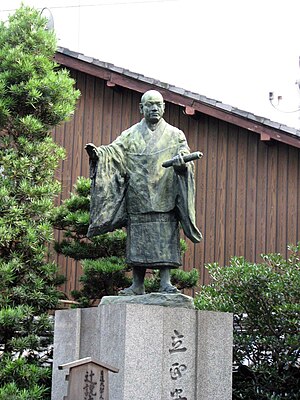Nichiren Buddhism


Nichiren Buddhism is a form of Buddhism based on the teachings of the 13th-century Japanese Buddhist priest Nichiren (1222–1282).[1]:239[2] Its teachings derive from some 300–400 extant letters and treatises attributed to Nichiren.[3][4][5]
Within Nichiren Buddhism there are two major divisions which fundamentally differ over whether Nichiren should be regarded as a bodhisattva of the earth, a saint, great teacher—or the actual Buddha of the third age of Buddhism.[6][7][8]
Nichiren Buddhism focuses on the Lotus Sutra doctrine that all people have an innate Buddha-nature and are therefore inherently capable of attaining enlightenment in their current form and present lifetime. Nichiren proposed a classification system that ranks the quality of religions[9][10]:128 and various Nichiren schools can be either accommodating or vigorously opposed to any other forms of Buddhism or religious beliefs.
There are three essential aspects to Nichiren Buddhism:
- The undertaking of faith.
- The practice of chanting Nam Myoho Renge Kyo accompanied by selected recitations of the Lotus Sutra and teaching others to do the same.
- The study of Nichiren’s scriptural writings called Gosho.[11]
The Nichiren Gohonzon is a calligraphic image which is prominently displayed in the home or temple buildings of its believers. The Gohonzon used in Nichiren Buddhism is composed of the names of key bodhisattvas and Buddhas in the Lotus Sutra as well as Namu-Myoho-Renge-Kyo written in large characters down the center.[7]:225
After his death, Nichiren left to his followers the mandate to widely propagate the Gohonzon and Daimoku in order to secure the peace and prosperity of society.[12]:99
Traditional Nichiren Buddhist temple groups are commonly associated with Nichiren Shoshu and varying Nichiren Shu schools. There are also modern 21st-century lay groups not affiliated with temples such as Soka Gakkai, Kenshokai, Shoshinkai, Risshō Kōsei Kai, and Honmon Butsuryū-shū.
Further reading
- Nichiren Buddhism (Wikipedia)
- Encyclopedia Britannica, "Soka Gakkai"
- East Asian Religions: Nichiren Buddhism
Notes
- ↑ Stone, Jacqueline I. (1999). "Priest Nisshin's Ordeals". Religions of Japan in practice. Tanabe, George J., Jr., 1943–. Princeton, NJ: Princeton University Press. ISBN 9780691057897. OCLC 39930710.
- ↑ Richard K. Payne, Re-Visioning Kamakura Buddhism (Studies in East Asian Buddhism) (Studies in East Asian Buddhism, 11), University of Hawaii Press, ISBN 978-0824820787, p. 24
- ↑ Iida, Shotaro (1987). "Chapter 5: 700 Years After Nichiren". In Nicholls, William. Modernity and Religion. Wilfrid Laurier University Press. pp. 98–105. ISBN 0-88920-154-4.
- ↑ Arai, Nissatsu (1893). Outlines of the Doctrine of the Nichiren Sect, Submitted to the Parliament of the World's Religions. Tokyo, Japan: Central Office of the Nichiren Sect. p. vi.
One who wants to know how high was his virtue, how profound and extensive was his learning, how heroic and grand was his character, and how gigantic and epoch-making was his mission, needs only to read his works.
- ↑ http://www.totetu.org/assets/media/paper/k018_258.pdf
- ↑ Hein, Patrick (2014). The Goddess and the Dragon: A Study on Identity Strength and Psychosocial Resilience in Japan. Cambridge Scholars Publishing. p. 67. ISBN 9781443868723.
- ↑ 7.0 7.1 Ellwood, Robert S.; Csikszentmihalyi, Mark A. (2003). "Chapter 12: East Asian Religions in Today's America". In Neusner, Jacob. World Religions in America: An Introduction. Westminster John Knox Press. p. 225. ISBN 9780664224752.
- ↑ Cornille, Catherine (1998). "Canon formation in new religious movements: The case of the Japanese new religions". In Debeek, A. Van; Van der Toorn, Karel. Canonization and Decanonization. Brill. p. 284. ISBN 9004112464.
- ↑ Petzold, Bruno (1995). Ichimura, Shohei, ed. The classification of Buddhism : comprising the classification of Buddhist doctrines in India, China and Japan = Bukkyō-kyōhan. Wiesbaden: Harrassowitz Verlag. p. 627. ISBN 9783447033732.
- ↑ Stone, Jacqueline I (2012). "The Sin of "Slandering the True Dharma" in Nichiren's Thought" (PDF). Sins and Sinners : Perspectives from Asian Religions. Granoff, P. E. (Phyllis Emily, 1947–), Shinohara, Koichi (1941–). Leiden: Brill. ISBN 9789004232006. OCLC 809194690.
- ↑ Fowler, Jeaneane and Merv (2009). Chanting in the Hillsides. Portland, Oregon: Sussex Academic Press. p. 141.
- ↑ Anesaki, Masaharu (1916). Nichiren, the Buddhist Prophet. Harvard University Press.
| This article includes content from Nichiren Buddhism on Wikipedia (view authors). License under CC BY-SA 3.0. |